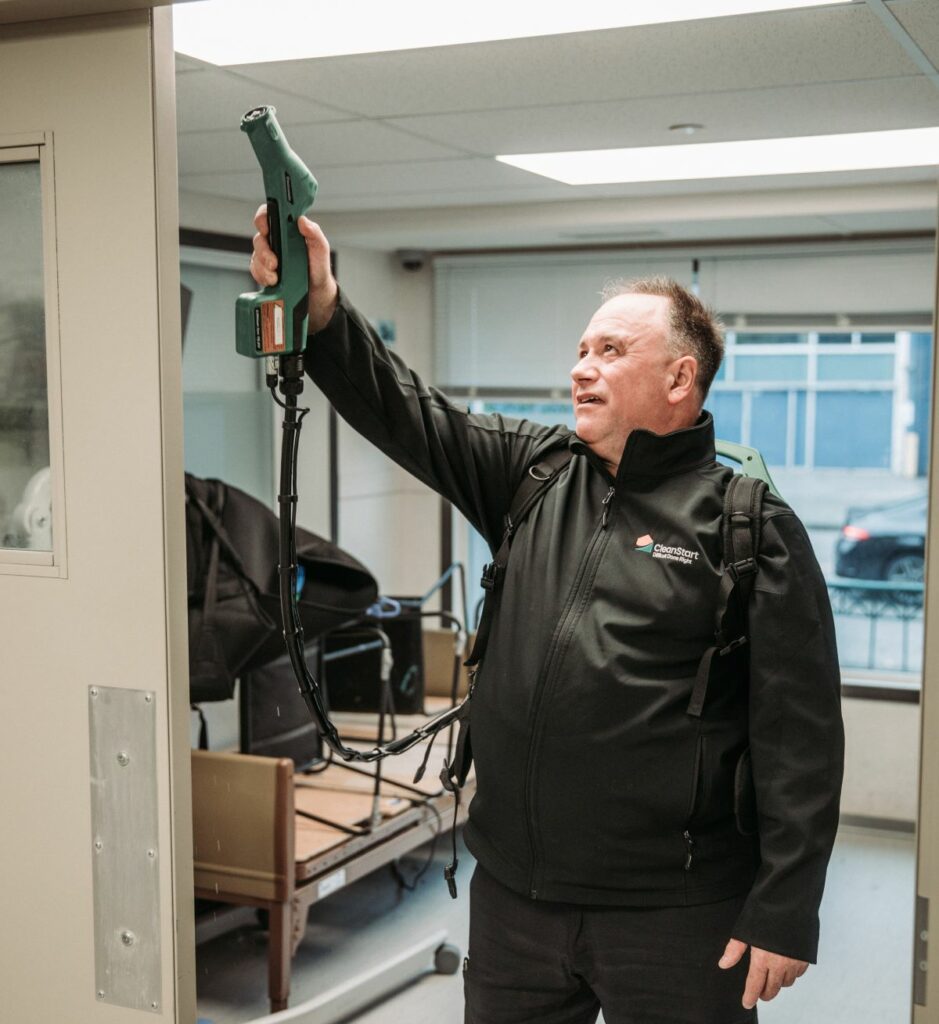Fogging is The Ultimate Deep Office Cleaning Method

Our friends at The Abbey Cleaning Service wrote an awesome article on how fogging is the ultimate deep office cleaning method. You can find the full article HERE.
Carrying out a deep office clean with fogging was once seen as a pretty drastic measure, and an obscure cleaning method reserved for extreme cleaning cases, outside of its most common applications.
That was, until the coronavirus pandemic.
All of a sudden, fogging office spaces and shared workspaces was embraced as a brilliant way of tackling the virus; a germ proven to be both airborne and able to survive on surfaces for extended periods of up to three days.
And so fogging – a once obscure cleaning practice among office cleaners – became pretty famous after the events of 2020. Foggers were even a common sight, where cleaners deployed the long-lasting chemical disinfectant from backpacks – sort of like Ghostbusters for COVID times.
Office managers started to take notice, too. And some office cleaners even branched out into offering fogging cleaning services, to fight back against COVID, and keep vital teams healthy and safe at work.
But what exactly is fogging? Is it harmful to people, office furniture, computers – or to office pets? And perhaps most importantly… Do offices still need to take so many precautions now that lockdowns and safety measures are lifted?
What is Fogging?
Fogging is a way of disinfecting an enclosed area with a “fog” of disinfectants. Cleaners in protective clothing, wearing specialized respirators, dispense the fog from spray guns.
The space is filled with a very fine mist of chemical disinfectant, which hangs in the air like a fog. Fogging is used regularly in a number of sectors, including the food industry, as it saturates pre-cleaned environments with disinfectant – destroying airborne microorganisms, and disinfecting hard-to-reach surfaces.
It is highly effective, while being faster than manually disinfecting each surface individually.
How Does Fogging Work?
Fogging is done in a number of ways.
In some buildings (like factories) that require regular deep cleaning, permanently installed systems periodically fog the workfloor when it’s not in use. In facilities which require less frequent disinfecting, or which cannot house permanent equipment, mobile fogging devices are used.
Mobile fogging is done by a trained cleaner – who must wear full PPE, including a sealed mask, breathing apparatus, gloves, and chemical suit.
The fogging process takes 15-30 minutes, depending on the size of the area being treated. After fogging, it can take 45-60 minutes for the mist to settle on all surfaces. After that, the settled residue may need to be wiped away, depending on the disinfectants used.
Fogging requires the premises to shut down completely during the cleaning process, and depending on the chemical disinfectant used, downtime can be up to six hours. The fog has to fully evaporate before people can re-enter the workplace safely.
Is Fogging Safe?
Fogging had been widely used for decades prior to the COVID pandemic, with little harm done to anyone but the germs. However, there are risks, and fogging must be carried out by trained professionals. All safety measures must be firmly adhered to, even if it means added downtime.
Exposure to the chemicals in airbourne disinfectants can cause skin, eye, or respiratory irritation. So, everyone must stay out of the area for the time indicated in the product label, and specified by the fogging device.
Any post-fogging cleaning (like residue removal) specified by the product should be carried out once it’s safe to do so.
Some are more vulnerable to certain chemicals, including children, animals and people with asthma – so the chosen method of fogging needs greater care depending on who’s using the space.
“Wet” foggers can also damage electronics – but there are other methods that are safe to use around office equipment (which we’ll get to). Special care also needs to be taken around food and food prep areas, too, to avoid contamination.
Not all foggers are equal – and there are many different techniques and chemicals specific to each use case.
Alternative Fogging Cleaning Techniques
So, if wet fogging is harmful to electronics, what’s the solution?
Dry fogging, of course!
So-called dry fogging uses a mixture of peroxyacetic acid and hydrogen peroxide (quite the mouthful, that!), which prevents damage caused by the moisture present in regular fogging methods. It’s not technically dry, in that it still uses aerosol mists – it just won’t interfere with electronics.
What about non-chemical alternatives? Well, short wave ultraviolet light can be used to kill microorganisms, but this only really works at surface level, and won’t penetrate into areas the light can’t shine.
UV treatment is highly effective on the surfaces it does reach – but if the environment contains a lot of plastics, extra care needs to be taken; certain plastics break down quickly in the presence of UV light.
For concentrated targeting, there’s Ultra Low Volume – or ULV fogging.
What is Ultra Low Volume (ULV) Fogging?
ULV involves highly-targeting misting with variable droplet sizes. This allows the precise application of a disinfecting mist – so instead of filling an entire room with fog, only key surfaces are treated. The key benefit of ULV fogging is that sensitive electrical equipment can be easily avoided by the process.
The Importance of Pre-Cleaning Before Fogging
Wait – if fogging is the ultimate office deep cleaning technique, why do you have to pre-clean the space first?
Well, if you’ve read up to here, you’ll probably be able to tell that fogging is not a standalone technique, or a “silver bullet”. Instead, it should be used in conjunction with hand-cleaning – particularly around sensitive equipment, people, and animals.
Fogging is a disinfection process, not a cleaning process. Thorough cleaning should be carried out before fogging – to remove dirt, dust and grime. It’s no good applying disinfectant to dirty surfaces, where microbes could find shelter and rise to prominence once again!
Do We Still Need to Worry About Fogging our Workplaces?
You’d think that, with lockdowns lifted and life returning to normal, fogging in your office is a thing of the past. And maybe it should be for most of us – now that hybrid working and WFH have affected office cleaning cycles.
But the coronavirus pandemic hasn’t gone away. The news cycle has certainly shifted – and our attention has been averted by other pressing issues – but COVID is still a thing. Yes, cases are lower; but don’t forget that in Wales alone, 10,789 people to date have tragically been lost to COVID-19.
Do we still need to fog disinfectants over our workspaces? Well, that depends on the nature of your business, the frequency of cleans, how many of your team work from home or on a hybrid basis… it’s entirely down to the company in question.
But what’s not up for debate is the need for regular, through office cleaning, particularly as we approach flu season (and what may now come to be known as “COVID season”).
We absolutely need to take care of our teams and our workspaces. And CleanStart Property Services is committed to upholding that for our own team, and for our customers. To find out more information on our janitorial cleaning and sanitization/fogging services click HERE.


